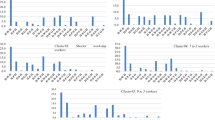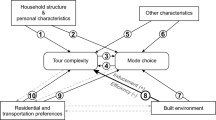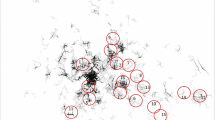Abstract
The primary purpose of this study was to investigate how relative associations between travel time, costs, and land use patterns where people live and work impact modal choice and trip chaining patterns in the Central Puget Sound (Seattle) region. By using a tour-based modeling framework and highly detailed land use and travel data, this study attempts to add detail on the specific land use changes necessary to address different types of travel, and to develop a comparative framework by which the relative impact of travel time and urban form changes can be assessed. A discrete choice modeling framework adjusted for demographic factors and assessed the relative effect of travel time, costs, and urban form on mode choice and trip chaining characteristics for the three tour types. The tour based modeling approach increased the ability to understand the relative contribution of urban form, time, and costs in explaining mode choice and tour complexity for home and work related travel. Urban form at residential and employment locations, and travel time and cost were significant predictors of travel choice. Travel time was the strongest predictor of mode choice while urban form the strongest predictor of the number of stops within a tour. Results show that reductions in highway travel time are associated with less transit use and walking. Land use patterns where respondents work predicted mode choice for mid day and journey to work travel.


Similar content being viewed by others
Notes
Some survey participants would only indicate whether their household income was below or above $35,000 per year. Most participants provided more detailed income data.
Abbreviations
- BMI :
-
Body mass index
- FAR:
-
Floor area ratio
- HBO:
-
Home-based non-work/other
- HBW:
-
Home-based work
- LUTAQH:
-
King county land use, transportation, air quality, and health study
- PSTP :
-
Puget sound transportation panel
- PSRC :
-
Puget sound regional council
- TAZ:
-
Traffic analysis zone
- WOW:
-
Work-based other
References
Boarnet, M.G., Crane, R.: Travel by design: the influence of urban form on travel. Oxford University Press, Oxford (2001)
TRB/IOM Committee on Physical Activity, Health, Transportation, and Land Use. Does the built environment influence physical activity? Examining the evidence. TRB Special Report, vol. 282 (2005)
Ewing, R., Cervero, R.: Travel and the built environment: a synthesis. Transportation research record J. Transport. Res. Board 1780, 87–114 (2001)
Frank, L.D.: Land use and transportation interaction: Implications on public health and quality of life. J. Plann. Edu. Res. 20, 6–22 (2000)
Frank, L.D., Andresen, M.A., Schmid, T.L.: Obesity relationships with community design, physical activity, and time spent in cars. Am. J. Preve. Med. 27, 87–96 (2004)
Frank, L., Engelke, P., Schmid, T.: Health and community design: the impacts of the built environment on physical activity. Island Press, Washington, DC (2003)
Frank, L.D., Pivo, G.: Impacts of mixed use and density on utilization of three modes of travel: single-occupant vehicle, transit, and walking. Transportation research record. J. Transport. Res. Board 1466, 44–52 (1995)
Frank, L.D., Sallis, J.F., Chapman, J., Saelens, B.E.: Linking objectively measured physical activity with objectively measured urban form: findings from SMARTRAQ. Am. J. Preve. Med. 28(2), 117–125 (2005)
Frank, L., Sallis, J.F., Conway, T., Chapman, J., Saelens, B., Bachman, W.: Multiple pathways from land use to health: walkability associations with active transportation, body mass index, and air quality. J. Am. Plann Assoc. 72(1), 75–87 (2006)
Frank L.D., Saelens, B., Powell, K.E., Chapman, J.: Stepping towards causation: do built environments or individuals preferences explain walking, driving, and obesity? Soc Sci Med. (2007). doi:10.1016/j.socscimed.2007.05.053
Handy, S., Cao, X., Mokhtarian, P.: Correlation or causality between the built environment and travel behavior? Evidence from Northern California. Transport. Res. D 10, 427–444 (2005)
Handy, S.: Travel behavior-land use interactions: an overview and assessment of the research. In: Mahmassini H.S. (ed.) Perpetual motion: travel behavior research opportunities and application challenges, pp. 223–236. Elsevier Science, Kidlington UK (2002)
Jang, T.Y.: Causal relationship among travel mode, activity, and travel patterns. J. Transport. Eng. 129(1), 16–22 (2003)
Krizek, K.J.: Operationalizing Neighborhood accessibility for land use travel behavior research and regional modeling. J. Plann. Edu. Res. 22(3), 270–287 (2003)
Lawrence Frank and Company, Inc., Sallis J., Saelens B., McCann Consulting, GeoStats LLC, Washbrook K.: A study of land use, transportation, air quality and health in King county, WA. King County Office of Regional Transportation Planning (2005)
Lee C.: Activity-friendly communities: correlates of transportation or recreation walking, and correlates of physical activity for different sub-populations, Dissertation, Seattle: Urban Design and Planning, University of Washington. Seattle, WA (2004)
Levine, J., Inam A., Torng, G.W.: A Choice-based rationale for land-use and transportation alternatives: evidence from Boston and Atlanta. J. Plann. Edu. Res. 24(1), 317–330 (2005)
Levine, J., Frank L.D.: Transportation (in press). DOI 10.1007/s11116–006-9104-6 (2006)
Miller, E.J., Roorda, M.J., Carrasco, J.A.: A tour-based model of travel mode choice. Transportation 32(4), 399–422 (2005)
Mitchell, R.B., Rapkin, C.: Urban traffic: a function of land use. Columbia University Press, New York (1954)
Moudon, A.V., Lee, C.C., Collier, A.D., Johnson, C.W., Schmid, D., Thomas, L., Weather, R.D.: Cycling and the built environment, a US perspective. Transport. Res. D 10(3), 245–261 (2005)
Saelens, B.E., Sallis, J.F., Frank, L.D.: Environmental correlates of walking and cycling: Findings from the transportation, urban design, and planning literatures. Ann. Behav. Med. 25, 80–91 (2003)
Sallis, J.F., Frank, L.D., Saelens, B.E., Kraft, M.K.: Active transportation and physical activity: Opportunities for collaboration on transportation and public health research. Transport Res. A Policy Pract. 38, 249–268 (2004)
Shiftan, Y., Ben-Akiva, M., Proussaloglou, K., De Jong, G., Yasasvi, P., Kasturirangan, K., Bekhor, S.: Activity-based modeling as a tool for better understanding travel behaviour. Paper Presented at the 10th Conference of the International Association of Travel Behavior Research, Lucerne, Switzerland (2003)
Unwin, D.J.: GIS, spatial analysis and spatial statistics. Prog. Hum. Geograp. 20(4), 540–441 (1996)
Zhan, G., Nigel, H., Wilson, M.: Assessment of the transfer penalty for transit trips: geographic information system-based disaggregate modeling approach. Transport. Res. Rec. 1872 (2004)
Acknowledgements
Foremost, we thank the Washington State Department of Transportation (WSDOT) for funding this study. We further acknowledge Ms. Jean Mabry, Ms. Kathy Lindquist, and Ms. Paula Reeves with WSDOT for input, direction, and guidance in this effort. Mr. Keith Lawton’s considerable assistance in formulating the study design and reviewing the work in various stages of completion was extremely helpful and is greatly appreciated. We thank the Puget Sound Regional Council for providing the travel survey data and King, Piece, Snohomish, and Kitsap Counties for the parcel data and Dr. Paul Waddell with the University of Washington for the enhancements to the parcel data used in this study. We thank Mr. Larry Blaine of the Puget Sound Region Council for his suggestions, feedback, and guidance throughout the project. We thank Dr. William Bachman for producing the shortest time path trip assignments used in our analyses. Mr. Chris Close is recognized for his efforts to develop the land use measures and to clean the parcel level land use data and for finding other sources of land use data to enable the study to proceed.
Author information
Authors and Affiliations
Corresponding author
Rights and permissions
About this article
Cite this article
Frank, L., Bradley, M., Kavage, S. et al. Urban form, travel time, and cost relationships with tour complexity and mode choice. Transportation 35, 37–54 (2008). https://doi.org/10.1007/s11116-007-9136-6
Published:
Issue Date:
DOI: https://doi.org/10.1007/s11116-007-9136-6




